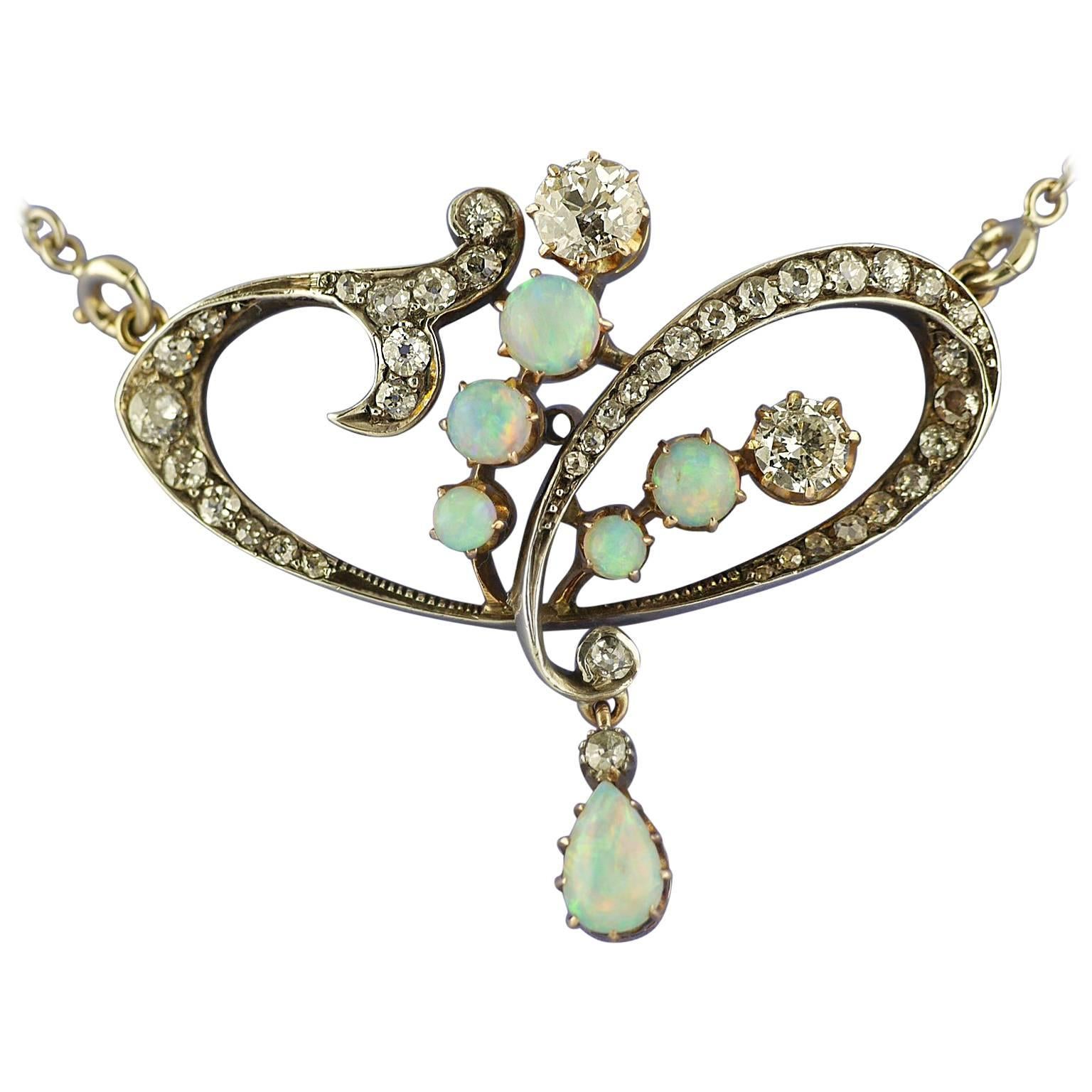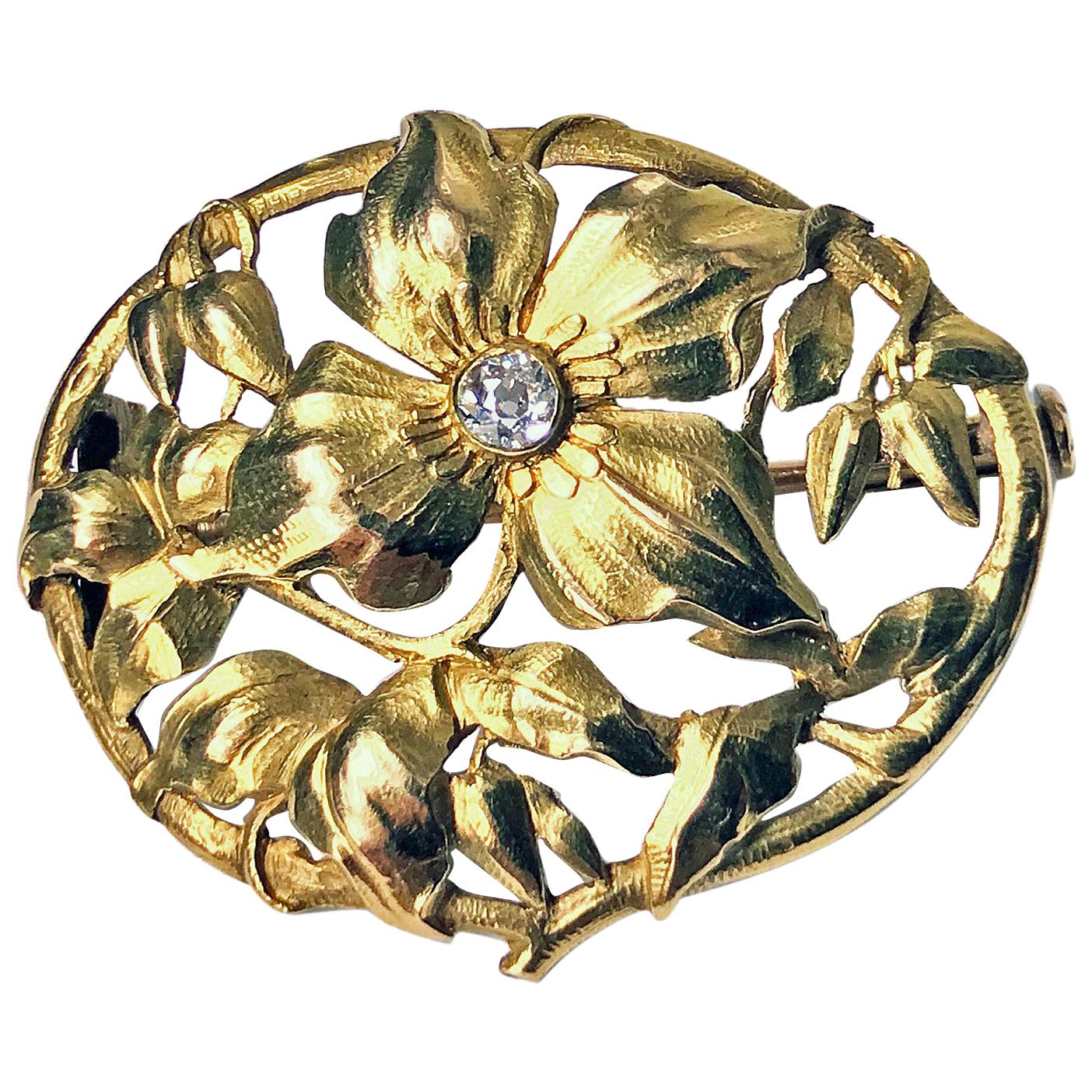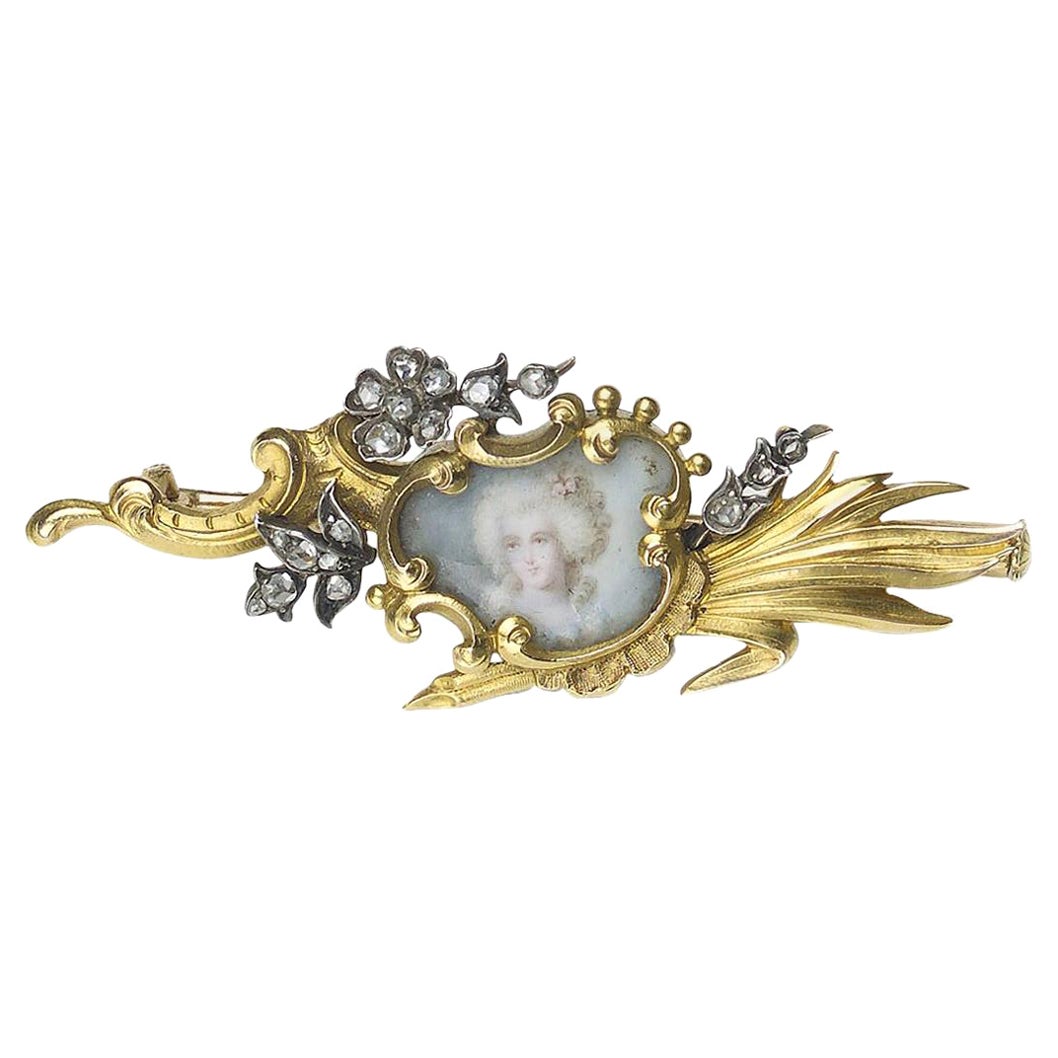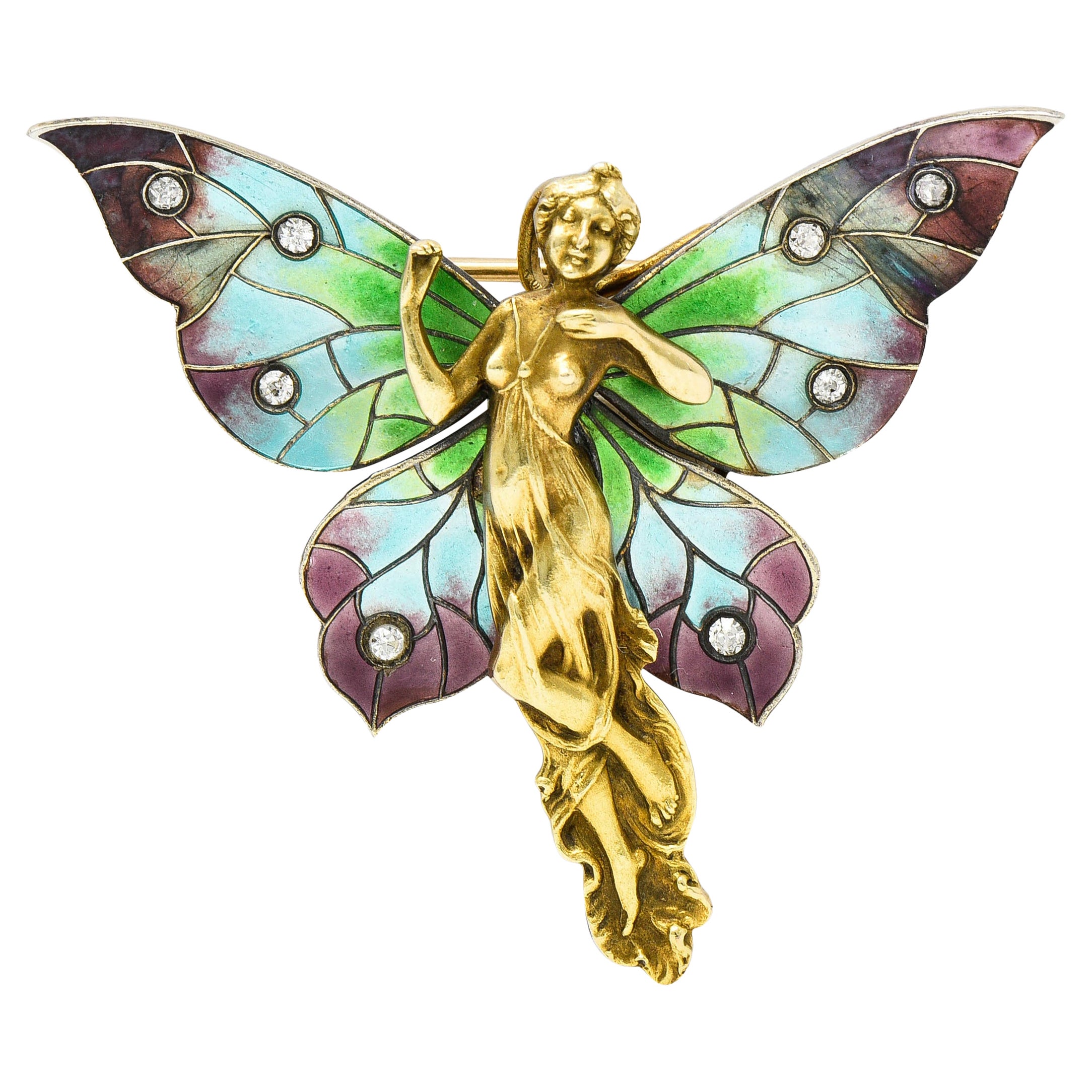Items Similar to Art Nouveau gold and diamond brooch, circa 1900.
Video Loading
Want more images or videos?
Request additional images or videos from the seller
1 of 6
Art Nouveau gold and diamond brooch, circa 1900.
About the Item
Signed Art Nouveau gold brooch set with rose cut diamonds. Set with eleven round rose cut diamonds in closed back grain settings with a combined approximate weight of 0.06 carats, to a swirling Art Nouveau design brooch, carved and engraved with the portrait of a lady wearing a diamond necklace and fur stole, encompassed by an undulating border of flower and leaf tendrils, fitted to reverse with a secure brooch pin, approximately 3cm in width. Tested yellow gold, signed 'Aubé', circa 1900.
- Metal:Gold
- Stone:Diamond
- Stone Cut:Rose Cut
- Style:Art Nouveau
- Period:1900-1909
- Date of Manufacture:1900
- Condition:Wear consistent with age and use.
- Seller Location:London, GB
- Reference Number:
About the Seller
5.0
Recognized Seller
These prestigious sellers are industry leaders and represent the highest echelon for item quality and design.
1stDibs seller since 2011
56 sales on 1stDibs
Typical response time: 3 hours
- ShippingRetrieving quote...Ships From: London, United Kingdom
- Return PolicyA return for this item may be initiated within 3 days of delivery.
More From This SellerView All
- Victorian Diamond and Enamel Tiger Brooch, American, circa 1900Located in London, GBVictorian diamond and enamel tiger brooch. Set to centre with a round old cut diamond in a closed back claw setting, with an approximate weight of 0.20 carats, further set with two r...Category
Antique Early 1900s American Late Victorian Brooches
MaterialsDiamond, 14k Gold, Enamel
- Carlo and Arthur Giuliano Antique Diamond Wing Brooch circa 1900Located in London, GBAntique diamond wing brooch, attributed to Carlo and Arthur Giuliano, circa 1900. A gold and silver brooch in the form of a pair of outstretched wings, the wings with one hundred and sixteen pavé set round old cut diamonds with an approximate total weight of 5.80 carats, and additionally set with two old cut drop shaped diamonds set to top and bottom of the centrepiece with an approximate total weight of 2.05 carats. Originally part of a hair ornament. In a fitted Wartski box, authentication courtesy of Wartski. This brooch appears in 'Pre-Raphaelite to Arts and Crafts Jewellery', by Charlotte Gere and Geoffrey Munn, p. 12. Please note shipping to the United States of America requires the purchaser to fill out a CBP 5106 customs form before the item is shipped. This form is a legal requirement for any item over $2,000 which is being imported into the United States. One of the details the form requests is the purchaser’s social security number or importer’s number. One of the most collectable makers of antique jewellery is the London house of Giuliano, founded by the Neapolitan-born Carlo Giuliano, and succeeded by his sons Carlo and Arthur Alphonse. Though unmarked, this piece is likely to have once been a part of a tiara or hair ornament made by Giuliano due to its similarity to other signed pieces by the firm. There are five known pieces, in addition to the present jewel, by Giuliano which are comprised of a pair of diamond set wings with a larger stone or stones placed at centre. All five—a convertible hair ornament/brooch, a tiara, and three brooches—appeared in Wartski’s 1989 exhibition Artists’ Jewellery: Pre-Raphaelite to Arts and Crafts, and additionally two of these five are featured in the book of the same title by Charlotte Gere and Geoffrey Munn. The present piece is most similar to the diamond hair ornament...Category
Antique Early 1900s Brooches
MaterialsYellow Gold, Silver
- Maison Vever Paris Enamel and Gold Brooch French circa 1900.By VeverLocated in London, GBEnamel and gold brooch by Maison Vever Paris, French, circa 1900. An 18 carat yellow gold brooch in the form of a circular shallow concave disk decorated with a poppy, a daisy and a ...Category
20th Century French Edwardian Brooches
MaterialsYellow Gold
- Child & Child Diamond Platinum Pendant Brooch, circa 1900Located in London, GBPendant brooch by Child & Child. A pendant/brooch in three detachable sections, the uppermost composed of an elongated octagon with inward bowed sides set with one central diamond in a collet setting with a weight of 2.50 carats, flanked by trefoil forms set with six diamonds in bead settings with a combined weight of 1.20 carats, on a ground of pierced millegrain vertical bars, and encircled by a single scalloped border of twenty six diamonds in bead settings with a combined weight of 13.00 carats; the middle section composed of one central diamond in a collet setting with a weight of 1.20 carats, on a ground of pierced millegrain horizontal bars, and encircled by a stylized laurel wreath set with eighteen diamonds in bead settings with a combined weight of 2.16 carats, surmounted with two diamonds in collet settings with a combined weight of 0.15 carats, and encircled by a further five diamonds in collet settings with a combined weight of 1.50 carats; the bottom section in the same format and settings as the middle with one central diamond at a weight of 0.45 carats, eighteen diamonds weighing 0.90 total carats, two diamonds at 0.10 total carats, and five diamonds at 0.50 total carats, and also with a lower pendant composed of one diamond in a collet setting with a weight of 0.40 carats, above a bell form set with two diamonds in bead settings with a combined weight of 0.60 carats and with three diamonds in bead settings with a combined weight of 0.15 carats, above two more articulated links one composed of a diamond in a collet setting with a weight of 0.25 carats, above one mounted in the same fashion with a weight of 0.15 carats, all above an inverted tear shape link set with two rose cut diamonds in bead settings with a combined weight of 0.03 carats; all set with cushion shape old cut diamonds unless specified, millegrained throughout, and with a grand total of ninety three cushion shape old cut diamonds with an approximate total weight of 25.20 carats, and two round rose cut diamonds with an approximate total weight of 0.03 carats. The upper section is set to reverse with an entirely removable brooch bar with secure C spring clasp, and further set with two loops for a necklace to be attached. Each of the three sections are set with thread bars to attach or remove accordingly, with two threads set to the upper to form a choice of brooch or pendant as desired. Tested platinum, with makers mark for Child and...Category
Antique Early 1900s English Edwardian Brooches
MaterialsDiamond, Platinum
- Carlo & Arthur Giuliano pearl and enamel brooch, circa 1900.By Carlo and Arthur GiulianoLocated in London, GBPearl and enamel brooch by Carlo and Arthur Giuliano. Set with ten round natural pearls in closed back rubover settings, to an elegant openwork floral spray shape cluster with very f...Category
Antique Early 1900s Brooches
MaterialsPearl, Yellow Gold, Enamel
- Art deco diamond brooch, French, circa 1920.Located in London, GBArt deco diamond brooch. Set to centre with one round old cut diamond in an open back rubover setting with an approximate weight of 0.85 carats, surrounded by 45 round old cut diamon...Category
Vintage 1920s French Art Deco Brooches
MaterialsDiamond, Platinum
You May Also Like
- Art Nouveau Diamond Opal Pendant/Brooch, circa 1900Located in London, GB18ct gold & silver set Art Nouveau Diamond Opal Pendant/Brooch dated circa 1900 Five round opals with an articulated pear shaped opal drop, very well matched with lively play of colours and iridescence in reds, greens, blues and gold. Set in 18 carat yellow gold claw collets Two main transitional cut (old mine) diamonds 0.70ct. Mix of old mine and rose cut diamonds in an 18 carat yellow gold with “silver Set” channel setting , approx 1 ct total. G/H/I, VS2-SI2. Total diamond weight: approx 1.7carats Setting diamonds in gold with a thin layer of silver, “silver set”, was a technique used in the Georgian/Victorian/Art Nouveau period as white coloured gold and platinum were not yet available. A very thin layer of silver was applied to the gold, on which the diamonds were set, to show them off to their best advantage (as the yellow would reflect and distort the white colour of the diamonds). The Art Nouveau period was a short lived but worldwide movement which reached its peak at the end of the 19th Century and the first decade of the 20th Century. It had its roots in the Pre Raphaelite and Arts and Crafts movements in Britain in the 1860’s. Artists, such as William Morris, took their inspiration from the flora and fauna of nature and rejected the mass industrialisation and mechanisation of the Victorian age. Art Nouveau continued with this theme and has a distinctive appearance with soft, curved shapes and lines and often depicted natural designs such as flowers, birds and the female form. Before the Art Nouveau period, the emphasis had been to design pieces with an emphasis on gem stones, diamonds, rubies emeralds etc. However, during the Art Nouveau period, jewellers adopted the idea of using other semi–precious stones “from nature” such as agate, garnet opal, moonstone, aquamarine and experimented with a wide variety of new techniques e.g. enamelling. The “New Art” style became a worldwide movement encompassing all disciplines of the arts, and world class artists as far afield as Gaudi with his “modernisme” architecture in Spain, Louis Comfort Tiffany in New York with objects, Galle Glass in France and the Liberty & Co Archibald Knox designs in Britain, Jugendstil in Northern Europe and Faberge in Russia. The movement flared brightly but briefly and by 1910 it was already going out of style to be replaced by Art Deco. In fitted period box. Detachable 18ct brooch...Category
Antique Early 1900s British Art Nouveau Pendant Necklaces
MaterialsWhite Diamond, Opal, Diamond, 18k Gold, Yellow Gold, Silver
- Art Nouveau Diamond Opal Pendant/Brooch, circa 1900Located in London, GB18ct gold & silver set Art Nouveau Diamond Opal Pendant/Brooch dated circa 1900 Five round opals with an articulated pear shaped opal drop, very well matched with lively play of colours and iridescence in reds, greens, blues and gold. Set in 18 carat yellow gold claw collets Two main transitional cut (old mine) diamonds 0.70ct. Mix of old mine and rose cut diamonds in an 18 carat yellow gold with “silver Set” channel setting , approx 1 ct total. G/H/I, VS2-SI2. Total diamond weight: approx 1.7carats Setting diamonds in gold with a thin layer of silver, “silver set”, was a technique used in the Georgian/Victorian/Art Nouveau period as white coloured gold and platinum were not yet available. A very thin layer of silver was applied to the gold, on which the diamonds were set, to show them off to their best advantage (as the yellow would reflect and distort the white colour of the diamonds). The Art Nouveau period was a short lived but worldwide movement which reached its peak at the end of the 19th Century and the first decade of the 20th Century. It had its roots in the Pre Raphaelite and Arts and Crafts movements in Britain in the 1860’s. Artists, such as William Morris, took their inspiration from the flora and fauna of nature and rejected the mass industrialisation and mechanisation of the Victorian age. Art Nouveau continued with this theme and has a distinctive appearance with soft, curved shapes and lines and often depicted natural designs such as flowers, birds and the female form. Before the Art Nouveau period, the emphasis had been to design pieces with an emphasis on gem stones, diamonds, rubies emeralds etc. However, during the Art Nouveau period, jewellers adopted the idea of using other semi–precious stones “from nature” such as agate, garnet opal, moonstone, aquamarine and experimented with a wide variety of new techniques e.g. enamelling. The “New Art” style became a worldwide movement encompassing all disciplines of the arts, and world class artists as far afield as Gaudi with his “modernisme” architecture in Spain, Louis Comfort Tiffany in New York with objects, Galle Glass in France and the Liberty & Co Archibald Knox designs in Britain, Jugendstil in Northern Europe and Faberge in Russia. The movement flared brightly but briefly and by 1910 it was already going out of style to be replaced by Art Deco. Detachable 18ct brooch...Category
Antique Early 1900s British Art Nouveau Pendant Necklaces
MaterialsDiamond, White Diamond, Opal, 18k Gold, Yellow Gold, Silver
- Art Nouveau 18 Karat Diamond Brooch, circa 1900Located in Toronto, ONArt Nouveau 18K Diamond Brooch, C.1900. The brooch of oval pierced foliate design, the main floral petal set in the centre with a small old cut diamond. Trombone clasp...Category
Early 20th Century Art Nouveau Brooches
MaterialsDiamond
- Art Nouveau 1.2ct Diamond 18K Gold Brooch circa 1900Located in Goettingen, DEArt Nouveau 1.2ct Diamond 18K Gold Brooch circa 1900 Magnificent Art Nouveau brooch made of high-quality gold in the form of an openwork cartouche made of very fine leaf tendrils an...Category
Antique Early 1900s German Art Nouveau Brooches
MaterialsDiamond, Oriental Pearl, 18k Gold, Yellow Gold, Silver
- Louis Aucoc French Art Nouveau Diamond And Gold Portrait Brooch, Circa 1900Located in London, GBA French, Art Nouveau, diamond and gold brooch, by Louis Aucoc, with a glazed cartouche, with a scrolled surrounding, displaying a painted portrait miniature of a lady, with an 18th ...Category
Antique Early 1900s French Art Nouveau Brooches
MaterialsDiamond, Gold
- Art Nouveau Diamond Enamel 14 Karat Gold Fairy Brooch, Circa 1900Located in Philadelphia, PABrooch is designed as a fairy with a highly rendered female form With spread wings shining with iridescent enamel - ombrè green, blue, and purple No loss - excellent for age Set w...Category
Antique Early 1900s Art Nouveau Brooches
MaterialsDiamond, White Diamond, Gold, 14k Gold, Yellow Gold, Enamel
Recently Viewed
View AllMore Ways To Browse
Nouveau Brooch
Mazer Sterling Fur Clip
Owl Pin With Diamonds And Coral
Costume Jewelry Of The 60s
Diamond Set Crescent Brooch
Tiffany Enamel Pin
Victorian Scarab Jewelry
Christmas Brooches And Pins
Cool Brooch
Gold Rubies Diamonds Brooch
Bolso Plata
Holiday Gifts For Men
Gold Pheasant Diamonds
Woven Chanel Brooch
Jeanne Boivin
Liz Taylor Owned Jewelry
Floral Brooch Opens Closes
Victorian Sterling Silver Brooch Germany





